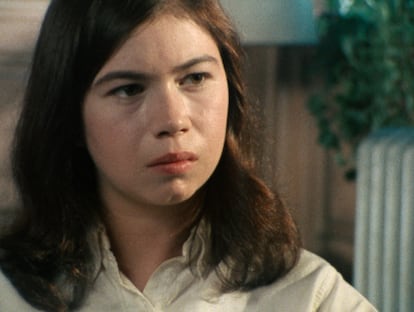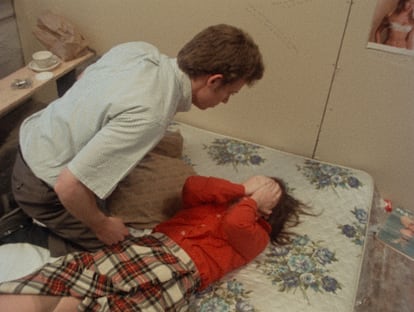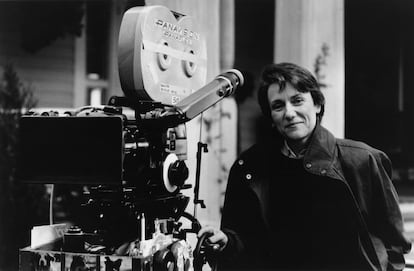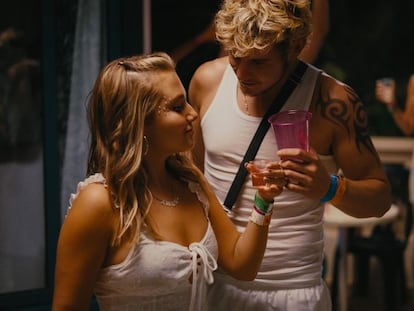‘Not a Pretty Picture,’ the movie that took on rape culture 50 years ago
Martha Coolidge’s courageous, devastating debut film is as relevant today as it was when it first came out

“Based on real events from the life of the director. The actress who plays Martha was also raped in high school. Names and places have been changed,” runs the explanation offered at the start of Not a Pretty Picture (1976), the courageous and devastating debut of the U.S. filmmaker Martha Coolidge (director of the cult rom-com Valley Girl and of episodes of popular series like Sex and the City and CSI: Las Vegas), which was restored in 2022 by the Academy Film Archive and the Film Foundation and selected by fellow director Céline Sciamma for the Retrospective section of the 2023 Berlinale. The movie is currently being re-released in Spanish theaters by distributor Atalante.
In 1962, when she was a 16-year-old boarding school student, Martha Coolidge, who was recently interviewed by film critic Elsa Fernández-Santos for EL PAÍS, was raped by an older classmate who had invited her to a party with some other friends. It wasn’t until her college years, at the age of 20, that she began to go to therapy and learned that what she had experienced was rape. “I didn’t go out with anyone for two years. The next year I went to another school. I remember I went on a couple of dates and cried the whole time,” Coolidge says at one point in Not a Pretty Picture. Twelve years later, her attack would inspire that first feature film of her career, a mixture of fiction and documentary in which the director confronts, analyzes and reflects on the sexual aggression she underwent. The director attempts to recreate the circumstances under which it all unfolded with a group of actors in a New York loft.

Nearly 50 years after its debut, Not a Pretty Picture not only continues to be a pioneering film when it comes to cinematographic representation of rape, abuse culture and consent, but also a work in astonishing, chilling dialogue with our present moment. Did I get myself into this situation? Did I somehow provoke him into raping me? Do I have part of the responsibility for what happened? Does having certain fantasies make me guilty? Could I have avoided it? Maybe it wasn’t the guy’s intention to do me harm, and I actually did something that led to this? What have been the consequences? Why did this happen to me? These are some of the questions presented in conversations between the director and her two protagonists — Michele Manenti, who was also raped as a teenager and Jim Carrington, who tries to understand and at certain points, justify his character’s behavior — and likely, continue to be posed today by many other victims of sexual violence.
In the New York loft where the rape is recreated, Coolidge both stages the events and elicits reflection and discussion from the film’s cast, giving space to different points of view held by both the actors and the characters they play. “It occurs to me that, just as I willingly lent myself to this film, I willingly sought out to be abused by a man in this way,” Manenti begins, explaining her motivation to Coolidge for being part of the film. “The only question I think you could ask yourself is whether you could have done something to prevent it,” Carrington says, perhaps thinking that such a line of reasoning would be helpful. And: “I know of so many cases from when I was in college, in which a woman was technically raped because she wasn’t giving her consent. It was supposed to be something mutual but… And there wasn’t necessarily any bad intention on the part of the guy, it was just that in that moment he needed it and thought that what he was doing was OK.” These conversations that take place throughout the film are one of its most interesting aspects, which wind up serving as a revealing look into the mirror of who we are as a society, of the turbulent power dynamics that are inherent to sexual violence, of how we confront abuse through the place where we lived it.

The eternal blaming of the victim, the impossibility of understanding the motivations of abuse, of how we continue to live with its impacts despite our attempt to start new chapters, how feelings of guilt and shame have been socially constructed, the false façade of the sexual aggressor, and how abusers are often normal, ordinary, apparently harmless people who come from the victim’s own circles, people who they trust. The distance between fantasy and reality, between the imaginary and the truth, consent, of how deeply rooted and widespread rape culture is in society, the complicit silence of those who know and yet, decide to look the other way. All this is reflected in a film in which violence jumps out in victim-blaming phrases normalized to this day: “Why are you here if you don’t want to kiss me?”
“And here I am, 28-and-a-half years old, and I’ve never had a serious relationship with a man. Sometimes I wonder… Perhaps it’s to protect myself. In part, it could be out of protection. I mean, I think it would take something incredible, something special that probably doesn’t exist, for me to be able to trust myself, because… because it scares me so much,” Coolidge ultimately confesses, in a heartbreaking sequence. And perhaps this is the film’s most devastating moment, in which we see how abuse and rape mark a victim’s life forever (even if she manages to “turn the page,” the scar never truly fades away), the realization that, despite the passage of time, things have not changed as much as it may seem. Despite the real progress that has been made, we still do not have all the answers when it comes to rape culture.
Sign up for our weekly newsletter to get more English-language news coverage from EL PAÍS USA Edition
Tu suscripción se está usando en otro dispositivo
¿Quieres añadir otro usuario a tu suscripción?
Si continúas leyendo en este dispositivo, no se podrá leer en el otro.
FlechaTu suscripción se está usando en otro dispositivo y solo puedes acceder a EL PAÍS desde un dispositivo a la vez.
Si quieres compartir tu cuenta, cambia tu suscripción a la modalidad Premium, así podrás añadir otro usuario. Cada uno accederá con su propia cuenta de email, lo que os permitirá personalizar vuestra experiencia en EL PAÍS.
¿Tienes una suscripción de empresa? Accede aquí para contratar más cuentas.
En el caso de no saber quién está usando tu cuenta, te recomendamos cambiar tu contraseña aquí.
Si decides continuar compartiendo tu cuenta, este mensaje se mostrará en tu dispositivo y en el de la otra persona que está usando tu cuenta de forma indefinida, afectando a tu experiencia de lectura. Puedes consultar aquí los términos y condiciones de la suscripción digital.
More information
Últimas noticias
Most viewed
- Sinaloa Cartel war is taking its toll on Los Chapitos
- Oona Chaplin: ‘I told James Cameron that I was living in a treehouse and starting a permaculture project with a friend’
- Reinhard Genzel, Nobel laureate in physics: ‘One-minute videos will never give you the truth’
- Why the price of coffee has skyrocketed: from Brazilian plantations to specialty coffee houses
- Silver prices are going crazy: This is what’s fueling the rally










































